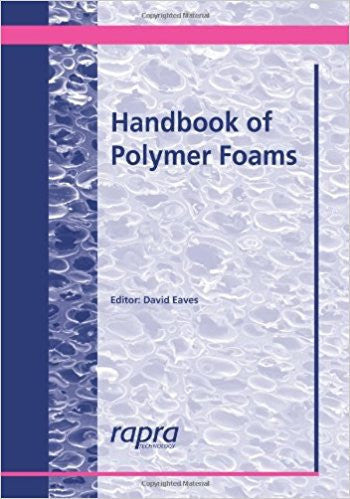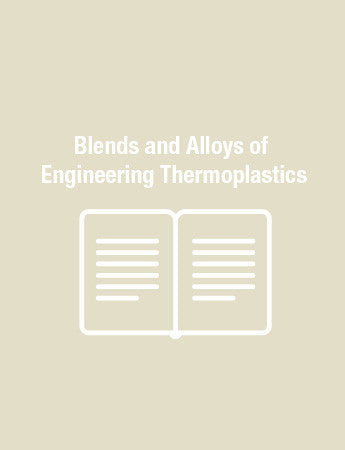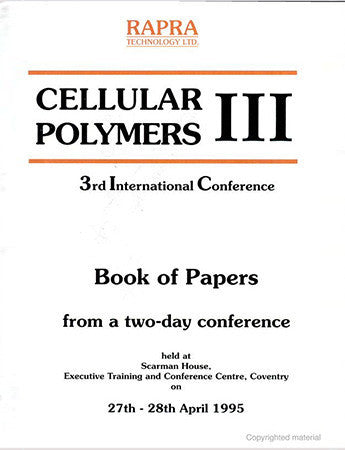Handbook of Polymer Foams
The use of polymer foams is extremely widespread. Indeed, it is hard to think of any industries where polymer foams do not have a part to play. They can be found for example in sports and leisure products, in military applications, in vehicles, in aircraft, and in the home. Most people will encounter polymer foams every day in one form or another, whether it be in furniture, in packaging, in their car, in refrigerator insulation, or in some other common application.
Although naturally occurring polymer foams have been known for a long time, (e.g., sponges, cork), synthetic polymer foams have only been introduced to the market over the last fifty years or so. The development of a new polymer has usually been quickly followed by its production in an expanded or foam form owing to the unique and useful properties, which can be realised in the expanded state.
This Handbook reviews the chemistry, manufacturing methods, properties and applications of the synthetic polymer foams used in most applications. In addition, a chapter is included on the fundamental principles, which apply to all polymer foams. There is also a chapter on the blowing agents used to expand polymers, blowing agents having undergone considerable change and development in recent years in order to meet the requirements of the Montreal Protocol in relation to the reduction and elimination of chloroflurocarbons (CFC) and other ozone depleting agents. A chapter is also included on microcellular foams - a relatively new development where applications are still being explored. Most chapters have references to facilitate further exploration of the topics. The chapters are all written by experts in the field.
This book will be of interest to those just embarking upon an exploration of the subject of foams, whether in industry or academia. But this will be equally useful to those already working in the field, who need to know about different types of foam.
Although naturally occurring polymer foams have been known for a long time, (e.g., sponges, cork), synthetic polymer foams have only been introduced to the market over the last fifty years or so. The development of a new polymer has usually been quickly followed by its production in an expanded or foam form owing to the unique and useful properties, which can be realised in the expanded state.
This Handbook reviews the chemistry, manufacturing methods, properties and applications of the synthetic polymer foams used in most applications. In addition, a chapter is included on the fundamental principles, which apply to all polymer foams. There is also a chapter on the blowing agents used to expand polymers, blowing agents having undergone considerable change and development in recent years in order to meet the requirements of the Montreal Protocol in relation to the reduction and elimination of chloroflurocarbons (CFC) and other ozone depleting agents. A chapter is also included on microcellular foams - a relatively new development where applications are still being explored. Most chapters have references to facilitate further exploration of the topics. The chapters are all written by experts in the field.
This book will be of interest to those just embarking upon an exploration of the subject of foams, whether in industry or academia. But this will be equally useful to those already working in the field, who need to know about different types of foam.
Preface
1 Foam Fundamentals (David Eaves, Independent Consultant)
1.1 Introduction
1.2 Foam Structure
1.3 Foam Properties
1.3.1 Compression Properties
1.3.2 Energy Absorption Properties
1.3.3 Thermal Properties
References
2 Blowing Agents (Sachida Singh, Huntsman Polyurethanes)
2.1 Introduction
2.2 Physical Blowing Agents
2.2.1 Selection Criteria for Physical Blowing Agents
2.2.2 Halogenated Hydrocarbons
2.2.3 Hydrocarbons (HC)
2.2.4 Inert Gases
2.2.5 Other Physical Blowing Agents
2.2.6 Blends of Physical Blowing Agents
2.2.7 Encapsulated Physical Blowing Agents
2.2.8 Physical Blowing Agent by Foam Type and Application
2.3 Chemical Blowing Agents
2.3.1 Selection Criteria for Chemical Blowing Agent
2.3.2 Exothermic CBA
2.3.3 Endothermic CBA
2.3.4 Endo/Exo Blends
References
3 Expanded Polystyrene: Development, Processing, Applications and Key Issues (Andrew Barnetson, BPF)
3.1 Introduction
3.1.1 Development of Expanded Polystyrene (EPS)
3.2 Manufacture of Expanded Polystyrene Mouldings
3.3 Applications for Expanded Polystyrene Packaging
3.3.1 Packaging
3.3.2 Construction
3.3.3 Other Applications
3.3.4 Novel Applications
3.4 Properties of EPS
3.4.1 Mechanical Performance
3.4.2 Thermal Insulation
3.4.3 Chemical Properties
3.4.4 Recent Research on Properties of EPS: Value for Fruit and Vegetables
3.5 Global Structure of Markets and Companies
3.5.1 Europe
3.5.2 Asia
3.5.3 USA
3.6 Key Issues Facing the EPS Industry
3.6.1 Fire
3.6.2 Recycling
3.6.2 Alternatives to Mechanical Recycling
Further Information
4 Rigid Polyurethane Foams (David Eaves, Independent Consultant)
4.1 Introduction
4.2 Materials
4.2.1 Polyols
4.2.2 Isocyanates
4.2.3 Blowing Agents
4.2.4 Other Additives
4.3 Manufacturing Processes for Rigid Polyurethane Foam
4.4 Recycling Processes for Rigid Polyurethane Foam
4.5 Properties of Rigid Polyurethane Foams
4.6 Applications
4.6.1 Applications in Construction
4.6.2 Applications in the Appliance Industry
References
5 Flexible Polyurethane Foam (Tyler Housel, Inolex Chemical Company)
5.1 Introduction
5.2 Chemistry
5.3 Starting Materials
5.3.1 Isocyanate
5.3.2 Polyol
5.3.3 Water
5.3.4 Surfactant
5.3.5 Catalyst
5.3.6 Colorants
5.3.7 Antioxidants
5.3.8 Light Stabilisers
5.3.9 Flame Retardants
5.3.10 Adhesion Promoters
5.3.11 Other Additives
5.4 The Foaming Process
5.4.1 Raw Material Conditioning
5.4.2 Mixing
5.4.3 Growth
5.4.4 Cell Opening
5.4.5 Cure
5.5 Manufacturing Equipment
5.5.1 Storage and Delivery
5.5.2 Mixing
5.5.3 Foam Rise and Cure
5.5.4 Innovations
5.6 Foam Characterisation
5.6.1 Density
5.6.2 Hardness
5.6.3 Resilience
5.6.4 Porosity
5.6.5 Strength Properties
5.6.6 Cell Structure
5.6.7 Environmental Stability
5.6.8 Fatigue
5.6.9 Compression Set
5.6.10 Flammability
5.7 FPF Markets
5.7.1 Transportation
5.7.2 Comfort
5.7.3 Carpet Cushion
5.7.4 Packaging
5.7.5 Specialty Applications
5.8 Environmental Issues
5.9 Organisations
References
6 Rigid PVC Foam (Noreen Thomas, University of Loughborough)
6.1 Introduction
6.2 Foam Extrusion
6.2.1 Basic Principles
6.2.2 Extrusion Processes
6.2.3 Effect of Processing Conditions
6.3 Foam Formulation Technology
6.3.1 Blowing Agents
6.3.2 Processing Aids
6.3.3 Type of PVC
6.3.4 Stabilisers
6.3.5 Lubricants
6.3.6 Typical Formulations
6.4 Properties
6.5 Novel Processes and Applications
6.5.1 Recycling
6.5.2 Microcellular Foam
6.5.3 Foamed Composites
6.6 Summary
References
7 Flexible PVC Foams (Chris Howick, EVC)
7.1 Introduction
7.2 Flexible Foam Types and PVC Types
7.2.1 Flexible Foams Based on Suspension PVC
7.2.2 Flexible Foams Based on Dispersion or Paste Resins
7.2.3 Chemically Blown Foams from PVC Plastisols: Fundamentals
7.2.4 PVC Resins used in Plastisol Foam Formation
7.2.5 Mineral Fillers
7.2.6 Pigments
7.2.7 Liquid Plasticiser
7.2.8 Blowing Agent Type and Level
7.3 Products Utilising Foamed Plastisols
7.3.1 Floorings and Carpet Backings
7.3.2 Wallcoverings
7.3.3 Synthetic Leather
7.3.4 General Foams
References
8 Polyolefin Foams (David Eaves, Independent Consultant)
8.1 Introduction
8.2 Manufacturing Processes and Materials
8.2.1 Extruded Non-Crosslinked Foam
8.2.2 Expanded (Non-Crosslinked) Polyolefin Beads
8.2.3 Extruded Crosslinked Foam - Processes
8.2.4 Press Moulded Crosslinked Foam Process
8.2.5 Injection Moulded Foam Process
8.2.6 The Nitrogen Autoclave Process
8.2.7 Recycling Processes
8.2.8 Post Manufacturing Operations
8.3 Properties of Polyolefin Foams
8.4 Applications
8.5 Foam Specifications
8.5.1 Packaging
8.5.2 Automotive
8.5.3 Furnishings
8.5.4 Buoyancy
8.5.5 Aerospace
8.5.6 Construction
8.5.7 Toys
8.5.8 Food contact
8.6 Markets
References
9 Latex Foam (Rani Joseph, Cochin University)
9.1 Introduction
9.2 Dunlop Process
9.2.1 Batch Process
9.2.2 Selecting a Formulation for Latex Compounds
9.2.3 Selection of Other Compounding Ingredients
9.2.4 Continuous Process for Latex Foam Production
9.3 Talalay Process
9.4 Trouble Shooting in Latex Foam Manufacture
9.5 Testing
9.5.1 Compression Set
9.5.2 Indentation Hardness
9.5.3 Flexing Resistance
9.5.4 Density
9.5.5 Metallic Impurities
9.6 Important Uses of Latex Foam
9.6.1 Transportation
9.6.2 Furniture
9.6.3 Special Uses
References
10 Microcellular Foams (Vipin Kumar, University of Washington & Krishna Nadella, University of Washington)
10.1 Introduction
10.2 Processing of Microcellular Foams
10.2.1 The Solid-State Batch Process
10.2.2 The Semi-Continuous Process
10.2.3 Extrusion and other Processing Methods
10.3 Properties of Microcellular Foams
10.4 Current Research Directions
10.4.1 Microcellular Materials for Construction
11.4.2 Open-Cell (Porous) Microcellular Foams
10.4.3 Sub-Micron Foams and Nanofoams
10.5 Commercial Opportunities
References
1 Foam Fundamentals (David Eaves, Independent Consultant)
1.1 Introduction
1.2 Foam Structure
1.3 Foam Properties
1.3.1 Compression Properties
1.3.2 Energy Absorption Properties
1.3.3 Thermal Properties
References
2 Blowing Agents (Sachida Singh, Huntsman Polyurethanes)
2.1 Introduction
2.2 Physical Blowing Agents
2.2.1 Selection Criteria for Physical Blowing Agents
2.2.2 Halogenated Hydrocarbons
2.2.3 Hydrocarbons (HC)
2.2.4 Inert Gases
2.2.5 Other Physical Blowing Agents
2.2.6 Blends of Physical Blowing Agents
2.2.7 Encapsulated Physical Blowing Agents
2.2.8 Physical Blowing Agent by Foam Type and Application
2.3 Chemical Blowing Agents
2.3.1 Selection Criteria for Chemical Blowing Agent
2.3.2 Exothermic CBA
2.3.3 Endothermic CBA
2.3.4 Endo/Exo Blends
References
3 Expanded Polystyrene: Development, Processing, Applications and Key Issues (Andrew Barnetson, BPF)
3.1 Introduction
3.1.1 Development of Expanded Polystyrene (EPS)
3.2 Manufacture of Expanded Polystyrene Mouldings
3.3 Applications for Expanded Polystyrene Packaging
3.3.1 Packaging
3.3.2 Construction
3.3.3 Other Applications
3.3.4 Novel Applications
3.4 Properties of EPS
3.4.1 Mechanical Performance
3.4.2 Thermal Insulation
3.4.3 Chemical Properties
3.4.4 Recent Research on Properties of EPS: Value for Fruit and Vegetables
3.5 Global Structure of Markets and Companies
3.5.1 Europe
3.5.2 Asia
3.5.3 USA
3.6 Key Issues Facing the EPS Industry
3.6.1 Fire
3.6.2 Recycling
3.6.2 Alternatives to Mechanical Recycling
Further Information
4 Rigid Polyurethane Foams (David Eaves, Independent Consultant)
4.1 Introduction
4.2 Materials
4.2.1 Polyols
4.2.2 Isocyanates
4.2.3 Blowing Agents
4.2.4 Other Additives
4.3 Manufacturing Processes for Rigid Polyurethane Foam
4.4 Recycling Processes for Rigid Polyurethane Foam
4.5 Properties of Rigid Polyurethane Foams
4.6 Applications
4.6.1 Applications in Construction
4.6.2 Applications in the Appliance Industry
References
5 Flexible Polyurethane Foam (Tyler Housel, Inolex Chemical Company)
5.1 Introduction
5.2 Chemistry
5.3 Starting Materials
5.3.1 Isocyanate
5.3.2 Polyol
5.3.3 Water
5.3.4 Surfactant
5.3.5 Catalyst
5.3.6 Colorants
5.3.7 Antioxidants
5.3.8 Light Stabilisers
5.3.9 Flame Retardants
5.3.10 Adhesion Promoters
5.3.11 Other Additives
5.4 The Foaming Process
5.4.1 Raw Material Conditioning
5.4.2 Mixing
5.4.3 Growth
5.4.4 Cell Opening
5.4.5 Cure
5.5 Manufacturing Equipment
5.5.1 Storage and Delivery
5.5.2 Mixing
5.5.3 Foam Rise and Cure
5.5.4 Innovations
5.6 Foam Characterisation
5.6.1 Density
5.6.2 Hardness
5.6.3 Resilience
5.6.4 Porosity
5.6.5 Strength Properties
5.6.6 Cell Structure
5.6.7 Environmental Stability
5.6.8 Fatigue
5.6.9 Compression Set
5.6.10 Flammability
5.7 FPF Markets
5.7.1 Transportation
5.7.2 Comfort
5.7.3 Carpet Cushion
5.7.4 Packaging
5.7.5 Specialty Applications
5.8 Environmental Issues
5.9 Organisations
References
6 Rigid PVC Foam (Noreen Thomas, University of Loughborough)
6.1 Introduction
6.2 Foam Extrusion
6.2.1 Basic Principles
6.2.2 Extrusion Processes
6.2.3 Effect of Processing Conditions
6.3 Foam Formulation Technology
6.3.1 Blowing Agents
6.3.2 Processing Aids
6.3.3 Type of PVC
6.3.4 Stabilisers
6.3.5 Lubricants
6.3.6 Typical Formulations
6.4 Properties
6.5 Novel Processes and Applications
6.5.1 Recycling
6.5.2 Microcellular Foam
6.5.3 Foamed Composites
6.6 Summary
References
7 Flexible PVC Foams (Chris Howick, EVC)
7.1 Introduction
7.2 Flexible Foam Types and PVC Types
7.2.1 Flexible Foams Based on Suspension PVC
7.2.2 Flexible Foams Based on Dispersion or Paste Resins
7.2.3 Chemically Blown Foams from PVC Plastisols: Fundamentals
7.2.4 PVC Resins used in Plastisol Foam Formation
7.2.5 Mineral Fillers
7.2.6 Pigments
7.2.7 Liquid Plasticiser
7.2.8 Blowing Agent Type and Level
7.3 Products Utilising Foamed Plastisols
7.3.1 Floorings and Carpet Backings
7.3.2 Wallcoverings
7.3.3 Synthetic Leather
7.3.4 General Foams
References
8 Polyolefin Foams (David Eaves, Independent Consultant)
8.1 Introduction
8.2 Manufacturing Processes and Materials
8.2.1 Extruded Non-Crosslinked Foam
8.2.2 Expanded (Non-Crosslinked) Polyolefin Beads
8.2.3 Extruded Crosslinked Foam - Processes
8.2.4 Press Moulded Crosslinked Foam Process
8.2.5 Injection Moulded Foam Process
8.2.6 The Nitrogen Autoclave Process
8.2.7 Recycling Processes
8.2.8 Post Manufacturing Operations
8.3 Properties of Polyolefin Foams
8.4 Applications
8.5 Foam Specifications
8.5.1 Packaging
8.5.2 Automotive
8.5.3 Furnishings
8.5.4 Buoyancy
8.5.5 Aerospace
8.5.6 Construction
8.5.7 Toys
8.5.8 Food contact
8.6 Markets
References
9 Latex Foam (Rani Joseph, Cochin University)
9.1 Introduction
9.2 Dunlop Process
9.2.1 Batch Process
9.2.2 Selecting a Formulation for Latex Compounds
9.2.3 Selection of Other Compounding Ingredients
9.2.4 Continuous Process for Latex Foam Production
9.3 Talalay Process
9.4 Trouble Shooting in Latex Foam Manufacture
9.5 Testing
9.5.1 Compression Set
9.5.2 Indentation Hardness
9.5.3 Flexing Resistance
9.5.4 Density
9.5.5 Metallic Impurities
9.6 Important Uses of Latex Foam
9.6.1 Transportation
9.6.2 Furniture
9.6.3 Special Uses
References
10 Microcellular Foams (Vipin Kumar, University of Washington & Krishna Nadella, University of Washington)
10.1 Introduction
10.2 Processing of Microcellular Foams
10.2.1 The Solid-State Batch Process
10.2.2 The Semi-Continuous Process
10.2.3 Extrusion and other Processing Methods
10.3 Properties of Microcellular Foams
10.4 Current Research Directions
10.4.1 Microcellular Materials for Construction
11.4.2 Open-Cell (Porous) Microcellular Foams
10.4.3 Sub-Micron Foams and Nanofoams
10.5 Commercial Opportunities
References
David Eaves studied polymer chemistry at the University in Birmingham and completed his doctorate in 1958. He then joined Dunlop in their Central Research and Development Laboratories in Birmingham, later going out to Ireland (Cork) and Japan (Kobe) to establish and manage overseas satellite research centres. In 1984 he left Dunlop and joined BP Chemicals' polyethylene foam operation in Croydon as Technical Manager. He was part of the management buy-out team in 1992 when the company was renamed 'Zotefoams', and retired in 1998 as Technical Director. He has published many papers on aspects of polymer and polymer foam technology and is the author of the Rapra report 'Polymer Foams: Trends in Use and Technology.




